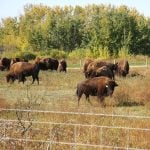How can the treaty rights of Indigenous peoples be honoured in a way that gives them a proper seat at the table when it comes to farming in Canada?

National Day for Truth and Reconciliation: Acknowledging the past, seeking a better future

OPINION: ‘Cows and plows’ settlement over a broken Indigenous treaty shows the urgent need for more transparent governance
Members of the Tootinaowaziibeeng Treaty Reserve (TTR) in Manitoba recently voted to ratify the Treaty 4 Agricultural Benefits Settlement Agreement. This cows-and-plows settlement is a step toward rectifying historical wrongs. The process has also highlighted several ongoing governing challenges. This includes exposing a flawed Crown/Indigenous consultation process as well as the need for trust-building with Indigenous leadership.

FCC Indigenous finance team tackles borrowing barriers
Farm lender provides ‘à la carte’ loan options to First Nations farmers
Reading Time: 4 minutes First Nations farmers have often been frozen out of agricultural lending. An all-Indigenous team at Farm Credit Canada (FCC) is working to ensure they get proper access to capital.

Agribition 2024: Indigenous Ag Summit focuses on community, partnership
Canadian Western Agribition’s 11th Indigenous Agriculture Summit focused on growing opportunities for Indigenous producers and using their ways of knowing to advance the ag industry.

Canada, First Nations agree on unmet agricultural claims
A handful of specific agricultural benefit claims between the federal government and nine First Nations were settled on Friday.
Once fully settled, these claims—unmet promises in treaties 5, 6 and 10 territories throughout the Prairie provinces—will represent almost $1.4 billion in combined compensation to these First Nations.

TRUTH AND RECONCILIATION: A ‘found generation’ of farmers
Faces of Ag: Does growing awareness of Métis heritage play a part in increasing numbers of Indigenous farmers?
Reading Time: 5 minutes Those with Indigenous heritage are increasingly self-identifying on StatCan agriculture surveys, especially Métis farmers.

Editor’s note: Truth and reconciliation is more than a day or slogan
If we as journalists want to champion truth and reconciliation in our agricultural community, we must do it year-round. We need to tell the truth the past, tune our ears to the viewpoints and culture of Indigenous farmers and leaders, and embrace the discomfort that comes with this.

Every child matters
A corn maze commemorating the lost children is a place to reflect and remember
Children run through the pathways of a corn maze designed to honour children who died while attending residential schools.

Reconciling the painful past creates hope for a more promising future
The File Hills Colony near Balcarres, Sask. epitomized everything that was wrong about colonial attitudes towards Indigenous peoples. But new models for Indigenous agriculture are emerging
More than a century after its creation, there is no visible sign remaining of the File Hills Farm Colony in southern Saskatchewan. But the painful memories of an experiment that epitomized the culture of assimilation permeating that era’s attitudes towards Canada’s Indigenous peoples still live in the collective memories of residential school survivors. Likewise for some of the racist attitudes and policies that still exist today.

Sharing the countryside
Finding a new way of living together is key to the future of rural Canada
The launch of the Treaty Land Sharing Network was about people who share the countryside, together setting a different course than the one scripted for them.

